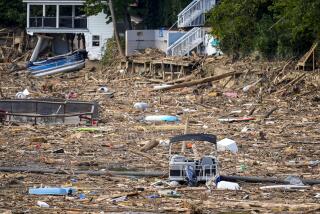The carbon dioxide precipice
- Share via
It is time for more of us to step forward. By “us” I mean the growing number of thoughtful Americans who have recognized the threat of global warming but have tried not to worry about it too much or get involved. Even our president, who talks eloquently about the need to reduce our fossil-fuel consumption, initially rebuffed an environmental group’s efforts to have the White House install solar panels (as detailed by Bill McKibben in his Sept. 16 Times Op-Ed article, “This is how they treat their friends?”). Sure, many of us have changed light bulbs and thermostats, and we drive fuel-efficient cars. We reduce, reuse, recycle and do countless other things to shrink our carbon footprint. But we have not yet admitted the size and complexity of the task we are facing.
I recently read “Storms of My Grandchildren: The Truth About the Coming Climate Catastrophe and Our Last Chance to Save Humanity.” The book is by James Hansen of NASA, who is widely regarded as the leading climatologist in the United States and perhaps the world. The title alone is enough to give us a sense of his assessment of our situation. The book has been out for almost a year, but it is still not widely known. It is time for more people to read it and act on its message.
A key part of Hansen’s message is that we must do everything possible to reduce our use of fossil fuels, especially coal. By burning these fuels, we are releasing more and more carbon dioxide into the atmosphere. The rapidly increasing level of carbon dioxide in the atmosphere is the major cause of the phenomenon known as global warming.
That rather mild descriptive phrase has not been enough to jolt us into action. Consider, by contrast, the title of a paper written by Hansen in 2003: “Can We Defuse the Global Warming Time Bomb?” This gets more to the point, which is to recognize the magnitude of the threat to our planet. As temperatures rise, the nearly irreplaceable glaciers around the world are melting and breaking up, raising sea levels and threatening huge populations living in low-lying areas. Storms are intensifying in many parts of the world. Seasons are changing. More and more species are struggling to survive. Rain forests are drying out. Coral reefs are dying. And the warming process is still in its early stages.
So what can we do about this? First, we have to understand that the level of carbon dioxide in the atmosphere when the Industrial Revolution began in the 18th century was about 280 ppm, or parts per million. Then we started to burn fossil fuels — coal, oil and natural gas. This led to a gradual increase in carbon dioxide, which became more rapid after the mid-20th century, until it stood at 387 ppm last year when Hansen’s book was published.
The work of Hansen and other leading climate scientists led McKibben to found an organization known as 350.org. The “350” in this name refers to 350 ppm, which these scientists believe is the highest level of carbon dioxide in the atmosphere that will allow Earth’s natural systems to endure in the long term without drastic changes.
The last time there was 350 ppm of carbon dioxide in the atmosphere was around 1985. So how we can get back to 350? That will take some major action. Hansen and others offer many proposals for starters.
Meanwhile, 350.org is coordinating volunteer events around the world Oct. 10 to celebrate10-10-10. More than 170 nations will be participating and more than 5,000 events are planned; some here in Los Angeles are posted on the 350.org website. The goal of these events is to publicize 350 and what it means. Many will include activities to improve our relations to the natural environment, including tree planting, water conservation, installing solar collectors, cleaning up stream beds and more. It is intended to be a day of action and to encourage political leaders to enact policies that will help reduce our impact on the planet.
There is much to be done. The sooner we act, the better chance there is to calm those storms that might otherwise affect our grandchildren.
James C. Stewart is a professor emeritus of environmental studies at Sonoma State University.






